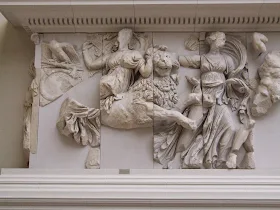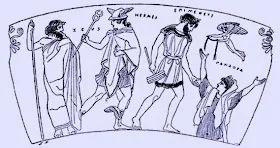Η
μεγαλύτερη Ρέα και ο μικροσκοπικός Επιμηθέας με φόντο τα δαχτυλίδια του Κρόνου.
Saturn has a great many more moons than our planet – a whopping 62. A
single moon, Titan, accounts for an overwhelming 96% of all the material orbit
the planet, with a group of six other smaller moons dominating the rest. The
other 55 small satellites whizzing around Saturn make up the tiny remainder
along with the gas giant’s famous rings. One of the subjects of this Cassini
image, Rhea, belongs to that group of six. Set against a backdrop showing
Saturn and its intricate system of icy rings, Rhea dominates the scene and
dwarfs its tiny companion, one of the 55 small satellites known as Epimetheus. Although
they appear to be close to one another, this is a trick of perspective – this
view was obtained when Cassini was some 1.2 million km from Rhea, and 1.6
million km from Epimetheus, meaning the moons themselves had a hefty separation
of 400 000 km. However, even if they were nearer to each other, Rhea would
still loom large over Epimetheus: at 1528 km across and just under half the
size of our own Moon, Rhea is well over 10 times the size of Epimetheus, which
is a modest 113 km across. As is traditional for the earliest discovered moons
of Saturn, both are named after figures from Greek mythology: the Titan Rhea
(“mother of the gods”) and Prometheus’ brother Epimetheus (“after thinker” or
“hindsight”). Image data credit: NASA/JPL-Caltech/Space Science Institute;
Processed image copyright: G. Ugarković
Δύο
από τους 62 δορυφόρους του Κρόνου προσπερνούν ο ένας τον άλλο σε αυτή την
εικόνα εξωγήινης ομορφιάς. Ο μικρός Επιμηθέας, διαμέτρου μόλις 113 χιλιομέτρων,
μοιάζει με νάνο κάτω από την επιβλητική σφαίρα της Ρέας, δέκα φορές
μεγαλύτερης.
Η
πορτοκαλί ατμόσφαιρα του Τιτάνα, εικόνα από την αποστολή Cassini. Titan in natural color. The thick
atmosphere is orange due to a dense organonitrogen haze.
Το
μεγαλύτερο από τα φεγγάρια του Κρόνου είναι ο Τιτάνας, ο οποίος αντιστοιχεί στο
96% της μάζας όλου του υλικού που περιφέρεται σε τροχιά γύρω από τον πλανήτη -όλοι
οι δορυφόροι συν το υλικό των δακτυλίων. Από το υπόλοιπο 4%, το μεγαλύτερο
μέρος αντιστοιχεί σε έξι σχετικά μεγάλους δορυφόρους, ανάμεσά τους και η Ρέα.
Η
Ρέα και ο Επιμηθέας μοιάζουν να βρίσκονται κοντά σε αυτή την εικόνα, στην
πραγματικότητα όμως απέχουν 400.000 χιλιόμετρα, με τη Ρέα να βρίσκεται σε πρώτο
πλάνο.
Η
Ρέα καβάλα στο λιοντάρι. Rhea rides on a lion, Pergamon Altar, Pergamon Museum,
Berlin.
Όπως
όλα τα φεγγάρια του Κρόνου, η Ρέα και ο Επιμηθέας παίρνουν ονόματα της
αρχαιοελληνικής μυθολογίας: η Ρέα είναι η Τιτανίδα μητέρα του Κρόνου, κόρη του
Ουρανού και της Γαίας.
Ο
επίσης Τιτάνας Επιμηθέας, αδελφός του Προμηθέα, ταυτίστηκε στην αρχαιότητα με
την απερισκεψία.
Η
εικόνα αναρτήθηκε στο δικτυακό τόπο της ευρωπαϊκής
διαστημικής υπηρεσίας ESA ως η «φωτογραφία της εβδομάδας». Ελήφθη
το Μάρτιο του 2010 από το διαστημικό σκάφος Cassini, το οποίο βρίσκεται στο
σύστημα του Κρόνου από το 2004, και υπέστη επεξεργασία από τον ερασιτέχνη
αστρονόμο Γκόρνταν Ουγκάρκοβιτς, ο οποίος αναρτά τις εντυπωσιακές εικόνες του στο
Flickr.
This image was taken
by Cassini’s narrow-angle camera on 24 March 2010, and processed by amateur
astronomer Gordan Ugarković. A
monochrome version was previously released by NASA as PIA12638: Big and Small Before Rings.
Η
αρχική εικόνα ήταν ασπρόμαυρη και τα χρώματα δεν ανταποκρίνονται απόλυτα στην
πραγματικότητα.





Δεν υπάρχουν σχόλια:
Δημοσίευση σχολίου